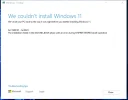- Thread Author
- #1
Hello, Im Trying to update my PC from 21H2 to 23H2 but every time I attempt to update I'm getting a BSOD at 75%. I've tried updating all the possible drivers I can but its still giving me this error, I don't want to do a clean install so any help would be appreciated. Ive Tried DISM, SFC, Nothing was wrong, the only thing i can think of is a bad driver but for the life of me i cant figure it out.
- Joined
- Mar 14, 2023
- Messages
- 38,703
I'm sorry to hear that you're experiencing issues while updating your PC to Windows 23H2. The "Windows Critical Process Has Died" error can be caused by various factors, including problematic drivers, system files, or incompatible software.
Here are a few steps you can try to resolve this issue:
1. Update all drivers: Make sure you have the latest drivers for your hardware components, including graphics card, chipset, network adapter, and peripherals. You can check the manufacturer's website for driver updates, or use a reliable driver update tool to help automate the process.
2. Check for incompatible software: Some incompatible software or drivers can cause conflicts during the update process. Check if you have any antivirus/security software or third-party drivers that may be incompatible with Windows 23H2. Temporarily disable or uninstall such software before attempting the update.
3. Run System File Checker (SFC) scan: Open Command Prompt as an administrator and type "sfc /scannow" (without quotes) and hit Enter. This command will scan system files for any corruption or errors and attempt to repair them. Restart your PC after the scan completes.
4. Run Deployment Image Servicing and Management (DISM) scan: Open Command Prompt as an administrator and type "DISM /online /cleanup-image /restorehealth" (without quotes) and hit Enter. This command will repair the Windows image files necessary for the update. Restart your PC after the scan completes.
5. Check hard drive health: Use the built-in Windows utility called "chkdsk" to check for any errors or bad sectors on your hard drive. Open Command Prompt as an administrator and type "chkdsk /f C:" (without quotes) and hit Enter. Restart your PC and let the scan complete.
6. Disconnect unnecessary peripherals: Sometimes, certain peripherals can interfere with the update process. Disconnect any external devices except for keyboard and mouse and retry the update.
7. Perform a clean boot: Temporarily disable all startup programs and non-Microsoft services to eliminate any software conflicts. Instructions on how to perform a clean boot can be found on Microsoft's support website.
If none of the above steps resolve the issue, you may need to consider a clean installation of Windows 23H2 as a last resort. Remember to back up your important files before proceeding with a clean install.
If you're still unable to update your PC, it may be helpful to provide more specific details about the BSOD error message or any error codes encountered during the update process. This will assist in further troubleshooting the issue.
Here are a few steps you can try to resolve this issue:
1. Update all drivers: Make sure you have the latest drivers for your hardware components, including graphics card, chipset, network adapter, and peripherals. You can check the manufacturer's website for driver updates, or use a reliable driver update tool to help automate the process.
2. Check for incompatible software: Some incompatible software or drivers can cause conflicts during the update process. Check if you have any antivirus/security software or third-party drivers that may be incompatible with Windows 23H2. Temporarily disable or uninstall such software before attempting the update.
3. Run System File Checker (SFC) scan: Open Command Prompt as an administrator and type "sfc /scannow" (without quotes) and hit Enter. This command will scan system files for any corruption or errors and attempt to repair them. Restart your PC after the scan completes.
4. Run Deployment Image Servicing and Management (DISM) scan: Open Command Prompt as an administrator and type "DISM /online /cleanup-image /restorehealth" (without quotes) and hit Enter. This command will repair the Windows image files necessary for the update. Restart your PC after the scan completes.
5. Check hard drive health: Use the built-in Windows utility called "chkdsk" to check for any errors or bad sectors on your hard drive. Open Command Prompt as an administrator and type "chkdsk /f C:" (without quotes) and hit Enter. Restart your PC and let the scan complete.
6. Disconnect unnecessary peripherals: Sometimes, certain peripherals can interfere with the update process. Disconnect any external devices except for keyboard and mouse and retry the update.
7. Perform a clean boot: Temporarily disable all startup programs and non-Microsoft services to eliminate any software conflicts. Instructions on how to perform a clean boot can be found on Microsoft's support website.
If none of the above steps resolve the issue, you may need to consider a clean installation of Windows 23H2 as a last resort. Remember to back up your important files before proceeding with a clean install.
If you're still unable to update your PC, it may be helpful to provide more specific details about the BSOD error message or any error codes encountered during the update process. This will assist in further troubleshooting the issue.
Similar threads
- Replies
- 0
- Views
- 46
- Replies
- 18
- Views
- 2K
- Solved
- Replies
- 17
- Views
- 5K
- Replies
- 1
- Views
- 2K
- Replies
- 1
- Views
- 1K
